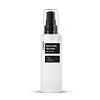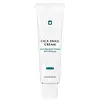What's inside
What's inside
 Key Ingredients
Key Ingredients

 Benefits
Benefits

 Concerns
Concerns

 Ingredients Side-by-side
Ingredients Side-by-side

Water
Skin ConditioningBetula Alba Juice
AstringentButylene Glycol
HumectantSodium Hyaluronate
HumectantGlycerin
HumectantGlycoproteins
Skin ConditioningBetaine
HumectantYeast Extract
Skin Conditioning1,2-Hexanediol
Skin ConditioningGlyceryl Acrylate/Acrylic Acid Copolymer
HumectantPropylene Glycol
HumectantGlyceryl Stearate
EmollientPEG-100 Stearate
Sea Water
HumectantCetearyl Alcohol
EmollientCetyl Ethylhexanoate
EmollientIsohexadecane
EmollientGalactomyces Ferment Filtrate
HumectantViola Mandshurica Flower Extract
AntioxidantMorus Alba Fruit Extract
AntioxidantGlycine Soja Seed Extract
Skin ConditioningSesamum Indicum Seed Extract
Skin ConditioningOryza Sativa Extract
AbsorbentTheobroma Cacao Extract
Skin ConditioningPanax Ginseng Berry Extract
Skin ConditioningSnail Secretion Filtrate
Skin ConditioningHydrolyzed Collagen
EmollientAdenosine
Skin ConditioningCopper Tripeptide-1
Skin ConditioningPolysorbate 60
EmulsifyingPEG-60 Hydrogenated Castor Oil
EmulsifyingSorbitan Stearate
EmulsifyingSodium Acrylate/Sodium Acryloyldimethyl Taurate Copolymer
Emulsion StabilisingPolysorbate 80
EmulsifyingStearic Acid
CleansingTriethanolamine
BufferingCarbomer
Emulsion StabilisingParfum
MaskingWater, Betula Alba Juice, Butylene Glycol, Sodium Hyaluronate, Glycerin, Glycoproteins, Betaine, Yeast Extract, 1,2-Hexanediol, Glyceryl Acrylate/Acrylic Acid Copolymer, Propylene Glycol, Glyceryl Stearate, PEG-100 Stearate, Sea Water, Cetearyl Alcohol, Cetyl Ethylhexanoate, Isohexadecane, Galactomyces Ferment Filtrate, Viola Mandshurica Flower Extract, Morus Alba Fruit Extract, Glycine Soja Seed Extract, Sesamum Indicum Seed Extract, Oryza Sativa Extract, Theobroma Cacao Extract, Panax Ginseng Berry Extract, Snail Secretion Filtrate, Hydrolyzed Collagen, Adenosine, Copper Tripeptide-1, Polysorbate 60, PEG-60 Hydrogenated Castor Oil, Sorbitan Stearate, Sodium Acrylate/Sodium Acryloyldimethyl Taurate Copolymer, Polysorbate 80, Stearic Acid, Triethanolamine, Carbomer, Parfum
Water
Skin ConditioningSnail Secretion Filtrate
Skin ConditioningGlycerin
HumectantCaprylic/Capric Triglyceride
MaskingCetearyl Alcohol
EmollientButylene Glycol
HumectantCaprylyl Methicone
Skin ConditioningCyclohexasiloxane
EmollientNiacinamide
SmoothingPolyglyceryl-3 Methylglucose Distearate
EmulsifyingHouttuynia Cordata Extract
Skin ConditioningCetearyl Glucoside
EmulsifyingEriophorum Spissum Flower/Stem Extract
Skin ConditioningPearl Extract
AntioxidantOpuntia Coccinellifera Fruit Extract
Skin ConditioningRoyal Jelly Extract
Skin ConditioningPropolis Extract
Skin ConditioningHoney
HumectantBetula Platyphylla Japonica Juice
Skin ConditioningBrassica Oleracea Italica Extract
AstringentRosa Damascena Flower Water
MaskingSasa Kurilensis Leaf/Stem Extract
AntimicrobialFragaria Chiloensis Fruit Extract
Skin ConditioningIllicium Verum Fruit Extract
PerfumingHydrolyzed Collagen
EmollientSodium Hyaluronate
HumectantHydrolyzed Hyaluronic Acid
HumectantSodium Acetylated Hyaluronate
HumectantPanthenol
Skin ConditioningAllantoin
Skin ConditioningArginine
MaskingAdenosine
Skin ConditioningMadecassoside
AntioxidantMadecassic Acid
Skin ConditioningAsiaticoside
AntioxidantAsiatic Acid
Skin ConditioningCopper Tripeptide-1
Skin ConditioningSh-Oligopeptide-1
Skin ConditioningAcetyl Hexapeptide-8
HumectantHydroxydecyl Ubiquinone
AntioxidantCeramide NP
Skin ConditioningTranexamic Acid
AstringentBeeswax
Emulsion StabilisingCitric Acid
BufferingSorbitan Olivate
EmulsifyingGlyceryl Stearate
EmollientSodium Polyacrylate
AbsorbentCarbomer
Emulsion Stabilising1,2-Hexanediol
Skin ConditioningBenzyl Glycol
SolventEthylhexylglycerin
Skin ConditioningDisodium EDTA
Water, Snail Secretion Filtrate, Glycerin, Caprylic/Capric Triglyceride, Cetearyl Alcohol, Butylene Glycol, Caprylyl Methicone, Cyclohexasiloxane, Niacinamide, Polyglyceryl-3 Methylglucose Distearate, Houttuynia Cordata Extract, Cetearyl Glucoside, Eriophorum Spissum Flower/Stem Extract, Pearl Extract, Opuntia Coccinellifera Fruit Extract, Royal Jelly Extract, Propolis Extract, Honey, Betula Platyphylla Japonica Juice, Brassica Oleracea Italica Extract, Rosa Damascena Flower Water, Sasa Kurilensis Leaf/Stem Extract, Fragaria Chiloensis Fruit Extract, Illicium Verum Fruit Extract, Hydrolyzed Collagen, Sodium Hyaluronate, Hydrolyzed Hyaluronic Acid, Sodium Acetylated Hyaluronate, Panthenol, Allantoin, Arginine, Adenosine, Madecassoside, Madecassic Acid, Asiaticoside, Asiatic Acid, Copper Tripeptide-1, Sh-Oligopeptide-1, Acetyl Hexapeptide-8, Hydroxydecyl Ubiquinone, Ceramide NP, Tranexamic Acid, Beeswax, Citric Acid, Sorbitan Olivate, Glyceryl Stearate, Sodium Polyacrylate, Carbomer, 1,2-Hexanediol, Benzyl Glycol, Ethylhexylglycerin, Disodium EDTA
Ingredients Explained
These ingredients are found in both products.
Ingredients higher up in an ingredient list are typically present in a larger amount.
1,2-Hexanediol is a synthetic liquid and another multi-functional powerhouse.
It is a:
- Humectant, drawing moisture into the skin
- Emollient, helping to soften skin
- Solvent, dispersing and stabilizing formulas
- Preservative booster, enhancing the antimicrobial activity of other preservatives
Adenosine is in every living organism. It is one of four components in nucleic acids that helps store our DNA.
Adenosine has many benefits when used. These benefits include hydrating the skin, smoothing skin, and reducing wrinkles. Once applied, adenosine increases collagen production. It also helps with improving firmness and tissue repair.
Studies have found adenosine may also help with wound healing.
In skincare products, Adenosine is usually derived from yeast.
Learn more about AdenosineButylene Glycol (or BG) is used within cosmetic products for a few different reasons:
Overall, Butylene Glycol is a safe and well-rounded ingredient that works well with other ingredients.
Though this ingredient works well with most skin types, some people with sensitive skin may experience a reaction such as allergic rashes, closed comedones, or itchiness.
Learn more about Butylene GlycolCarbomer is a polymer of acrylic acid. Its main role is to create a gel consistency.
A high amount of carbomer can cause pilling or balling up of products. Don't worry, most products contain 1% or less of carbomer.
Cetearyl alcohol is a mixture of two fatty alcohols: cetyl alcohol and stearyl alcohol. It is mainly used as an emulsifier. Emulsifiers help prevent the separation of oils and products. Due to its composition, it can also be used to thicken a product or help create foam.
Cetearyl alcohol is an emollient. Emollients help soothe and hydrate the skin by trapping moisture.
Studies show Cetearyl alcohol is non-toxic and non-irritating. The FDA allows products labeled "alcohol-free" to have fatty alcohols.
This ingredient is usually derived from plant oils such as palm, vegetable, or coconut oils. There is debate on whether this ingredient will cause acne.
Due to the fatty acid base, this ingredient may not be Malassezia folliculitis safe.
Learn more about Cetearyl AlcoholCopper Tripeptide-1 (GHK-Cu) is a skin repairing ingredient known for its ability to boost collagen, improve firmness, and support skin regeneration.
It is a complex made up of a naturally occurring peptide (glycine-histidine-lysine) and copper, an essential trace element.
While studying wound healing, researchers noticed GHK-Cu stimulated hair follicle enlargement and growth by keeping hair in its active growth phase longer. This has made it a promising ingredient for hair regrowth treatments.
Some people have reported increased facial hair. While GHK-Cu can make your hair follicles bigger, it usually doesn’t turn soft, barely-visible facial hairs into thick, dark ones.
Anecdotal reports suggest that overusing copper peptides might lead to premature aging due to excess free copper or enzyme imbalances. This claim isn’t backed by large-scale studies.
Unfortunately, there are limited human studies for this ingredient. While early results are promising, many studies are either small, in-vitro, or not rigorously controlled.
For example, there is a 1998 study that explored the effects of copper tripeptide, vitamin C, tretinoin, and melatonin on skin repair and collagen synthesis.
After one month, increased procollagen production was seen in 7 out of 10 participants using copper tripeptide (more than those using vitamin C, melatonin, or tretinoin.
While the study was exploratory, it offers early evidence that copper tripeptide may support collagen production. Larger, well-designed trials are still needed to confirm its potential and understand individual responses.
Read more about other common types of peptides here:
Learn more about Copper Tripeptide-1Glycerin is already naturally found in your skin. It helps moisturize and protect your skin.
A study from 2016 found glycerin to be more effective as a humectant than AHAs and hyaluronic acid.
As a humectant, it helps the skin stay hydrated by pulling moisture to your skin. The low molecular weight of glycerin allows it to pull moisture into the deeper layers of your skin.
Hydrated skin improves your skin barrier; Your skin barrier helps protect against irritants and bacteria.
Glycerin has also been found to have antimicrobial and antiviral properties. Due to these properties, glycerin is often used in wound and burn treatments.
In cosmetics, glycerin is usually derived from plants such as soybean or palm. However, it can also be sourced from animals, such as tallow or animal fat.
This ingredient is organic, colorless, odorless, and non-toxic.
Glycerin is the name for this ingredient in American English. British English uses Glycerol/Glycerine.
Learn more about GlycerinGlyceryl Stearate is a mix of glycerin and stearic acid.
It is used to stabilize the mixing of water and oil ingredients. By preventing these ingredients from separating, it can help elongate shelf life. It can also help thicken the product's texture.
As an emollient, it helps soften skin and supports barrier-replenishing ingredients.
In cosmetics, Glyceryl Stearate is often made from vegetable oils or synthetically produced.
This ingredient may not be fungal-acne safe
Fun fact: The human body also creates Glyceryl Stearate naturally.
Learn more about Glyceryl StearateHydrolyzed collagen has a misleading name because it is actually a mixture of various proteins/peptides. This ingredient has skin hydrating properties.
Collagen is the most abundant type of structural protein found in your body. In your skin, it is responsible for keeping it firm and youthful.
Hydrolyzed Collagen is created by breaking up proteins into smaller peptide bonds. These peptides act as humectants and emollients.
Humectants are great at holding onto water, keeping skin hydrated. Emollients create a thin barrier on the skin to prevent moisture from escaping.
There is ongoing debate about whether hydrolyzed collagen works because it increases skin hydration. Skin hydration is also linked to elasticity and the appearance of wrinkles.
Collagen or peptide ingredients can be used in the morning or night. They will not increase sun sensitivity, but you should always wear sunscreen during the day.
According to a manufacturer, this ingredient is a great hair conditioner as well.
This ingredient can be extracted from different sources, including:
Vegan collagen is derived from yeast, bacteria, or plant sources. Vegan collagen would go by a different INCI name, such as hydrolyzed soy protein.
The results are varied.
A study from 2021 found hydrolyzed collagen increased elasticity and improved wrinkles in 1,125 participants between age 20 and 70. Another study found increased skin thickness in participants between the ages of 45 to 59.
However, It is difficult to prove that oral collagen will end up working on your skin. Many of the studies using hydrolyzed collagen also add several vitamins and nutrients into the test mixture as well.
Further studies are needed at this time.
Learn more about Hydrolyzed CollagenSnail Secretion Filtrate is the excretion from snails. It is an effective moisturizer and promotes collagen production.
A popular nickname for this ingredient is 'Snail Mucin'.
Snail mucin has numerous skin benefits:
On top of this, Snail Secretion Filtrate contains a variety of vitamins and minerals. These include copper peptides, Vitamin A, and vitamin E. Vitamins A and E are antioxidants. Antioxidants help fight free-radicals that damage skin cells.
Being cruelty-free means a brand does not experiment on animals.
If you're worried about the well-being of the snails, we recommend looking more into the company of the product. Many brands have developed humane methods to collect snail mucin.
There is much debate on this subject. On one hand, this ingredient comes from an animal. On the other hand, many will argue the ingredient is naturally secreted (like a natural by-product) and therefore vegan. If you have reservations, you can look into Galactomyces Ferment Filtrate or Centella Asiatica Extract as alternatives.
Learn more about Snail Secretion FiltrateSodium Hyaluronate is hyaluronic acid's salt form. It is commonly derived from the sodium salt of hyaluronic acid.
Like hyaluronic acid, it is great at holding water and acts as a humectant. This makes it a great skin hydrating ingredient.
Sodium Hyaluronate is naturally occurring in our bodies and is mostly found in eye fluid and joints.
These are some other common types of Hyaluronic Acid:
Learn more about Sodium HyaluronateWater. It's the most common cosmetic ingredient of all. You'll usually see it at the top of ingredient lists, meaning that it makes up the largest part of the product.
So why is it so popular? Water most often acts as a solvent - this means that it helps dissolve other ingredients into the formulation.
You'll also recognize water as that liquid we all need to stay alive. If you see this, drink a glass of water. Stay hydrated!
Learn more about Water